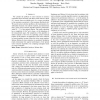Free Online Productivity Tools
i2Speak
i2Symbol
i2OCR
iTex2Img
iWeb2Print
iWeb2Shot
i2Type
iPdf2Split
iPdf2Merge
i2Bopomofo
i2Arabic
i2Style
i2Image
i2PDF
iLatex2Rtf
Sci2ools
CDC
2010
IEEE
2010
IEEE
Greedy sensor selection: Leveraging submodularity
ACT We consider the problem of sensor selection in resource constrained sensor networks. The fusion center selects a subset of k sensors from an available pool of m sensors according to the maximum a posteriori or the maximum likelihood rule. We cast the sensor selection problem as the maximization of a submodular function over uniform matroids, and demonstrate that a greedy sensor selection algorithm achieves performance within (1 - 1 e ) of the optimal solution. The greedy algorithm has a complexity of O(n3 mk), where n is the dimension of the measurement space. The complexity of the algorithm is further reduced to O(n2 mk) by exploiting certain structural features of the problem. An application to the sensor selection in linear dynamical systems where the fusion center employs Kalman filtering for state estimation is considered. Simulation results demonstrate the superior performance of the greedy sensor selection algorithm over competing techniques based on convex relaxation.
| Added | 13 May 2011 |
| Updated | 13 May 2011 |
| Type | Journal |
| Year | 2010 |
| Where | CDC |
| Authors | Manohar Shamaiah, Siddhartha Banerjee, Haris Vikalo |
Comments (0)

